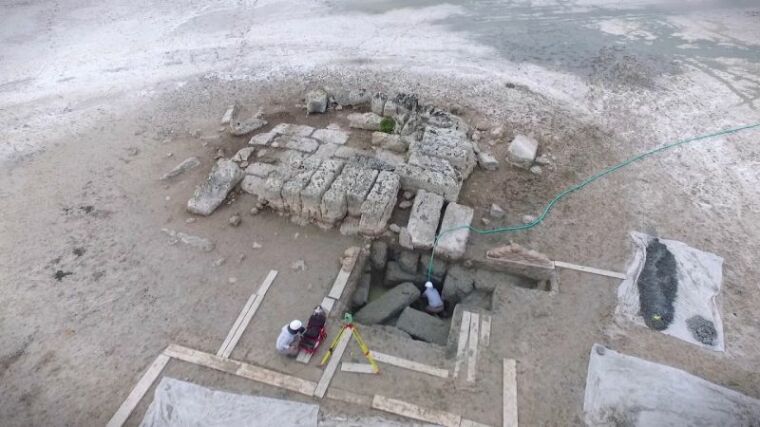Biblical city thought to be destroyed by quake 1,400 years ago uncovered in new underwater excavations

Archaeologists have found the Biblical city of Corinth which was thought to be destroyed by a massive earthquake in the sixth or early seventh century A.D.
The underwater excavations conducted by Greek and Danish archaeologists have uncovered traces of Roman engineering and ancient buildings at the ancient Corinth port of Lechaion, which was previously one of two ports that connected the city to Mediterranean trade networks.
"For almost two decades I have been hunting for the perfect archaeological context where all the organic material normally not found on land is preserved. The potential for more unique discoveries is mind blowing," Bjørn Lovén, the director of the excavation project, said according to Express.
The ancient Greek city holds significance for Christians as the apostle Paul was believed to have visited it while it was under Roman rule. He had also penned two letters that are now part of the Bible's New Testament as the books of 1 Corinthians and 2 Corinthians.
Corinth rose to prominence under the ancient Greeks, and it was sacked by the Romans in 146 B.C. It was left in ruins for more than 100 years before it was rebuilt by Julius Caesar in 44 B.C.
The excavations in the area began in 2015 as part of the Lechaion Harbour Project (LHP), which is a collaboration of the Ephorate of Underwater Antiquities in Greece, the Danish Institute of Athens and the University of Copenhagen.
The archaeologists found what they believed to be the remains of an ancient lighthouse which was depicted on coins from that time. Experts also uncovered rubble from another monument, but they have been unable to confirm its exact purpose. Archaeologists have speculated that it could be a religious sanctuary, the base of a large statue or a customs office.
"The island monument was destroyed by an earthquake between 50 and 125 AD. It may well be the first evidence of the earthquake of circa AD 70 under the emperor Vespasian mentioned in ancient literary sources," said Guy Sanders, who previously lead projects at Corinth.
A massive earthquake struck the port of Lechaion in the sixth or early seventh century A.D., but wooden foundations in the area were well preserved in addition to other artifacts, such as fishing lines and hooks, ceramics and wooden pulleys.
It was once thought that the quake had destroyed the city, but it may have helped preserve the artifacts by covering them in layers of sediment.
The experts were able to discover a new harbor basin after mapping the coastal changes in the area using core drilling and drone surveys. A sediment study is revealing how the harbor silted over time and which part of it would have been accessible in different periods.
According to The Guardian, the excavations will continue next year and it is expected to reveal more details about ancient engineering. The project was funded by Her Majesty the Queen Margrethe II's Archaeological Foundation, Augustinus Foundation, and Carlsberg Foundation.
 Christians don't have to affirm transgenderism, but they can’t express that view at work: tribunal
Christians don't have to affirm transgenderism, but they can’t express that view at work: tribunal Archaeology discovery: Medieval Christian prayer beads found on Holy Island
Archaeology discovery: Medieval Christian prayer beads found on Holy Island Presbyterian Church in America votes to leave National Association of Evangelicals
Presbyterian Church in America votes to leave National Association of Evangelicals Over 50 killed in 'vile and satanic' attack at Nigerian church on Pentecost Sunday
Over 50 killed in 'vile and satanic' attack at Nigerian church on Pentecost Sunday Ukrainian Orthodox Church severs ties with Moscow over Patriarch Kirill's support for Putin's war
Ukrainian Orthodox Church severs ties with Moscow over Patriarch Kirill's support for Putin's war Islamic State kills 20 Nigerian Christians as revenge for US airstrike
Islamic State kills 20 Nigerian Christians as revenge for US airstrike Man who served 33 years in prison for murder leads inmates to Christ
Man who served 33 years in prison for murder leads inmates to Christ


 Nigerian student beaten to death, body burned over ‘blasphemous’ WhatsApp message
Nigerian student beaten to death, body burned over ‘blasphemous’ WhatsApp message 'A new low': World reacts after Hong Kong arrests 90-year-old Cardinal Joseph Zen
'A new low': World reacts after Hong Kong arrests 90-year-old Cardinal Joseph Zen Iran sentences Christian man to 10 years in prison for hosting house church worship gathering
Iran sentences Christian man to 10 years in prison for hosting house church worship gathering French Guyana: Pastor shot dead, church set on fire after meeting delegation of Evangelicals
French Guyana: Pastor shot dead, church set on fire after meeting delegation of Evangelicals ‘Talking Jesus’ report finds only 6% of UK adults identify as practicing Christians
‘Talking Jesus’ report finds only 6% of UK adults identify as practicing Christians Mission Eurasia ministry center blown up in Ukraine, hundreds of Bibles destroyed: 'God will provide'
Mission Eurasia ministry center blown up in Ukraine, hundreds of Bibles destroyed: 'God will provide' Church holds service for first time after ISIS desecrated it 8 years ago
Church holds service for first time after ISIS desecrated it 8 years ago Burger King apologizes for 'offensive campaign' using Jesus' words at the Last Supper
Burger King apologizes for 'offensive campaign' using Jesus' words at the Last Supper Uganda: Muslims abduct teacher, burn him inside mosque for praying in Christ’s name
Uganda: Muslims abduct teacher, burn him inside mosque for praying in Christ’s name